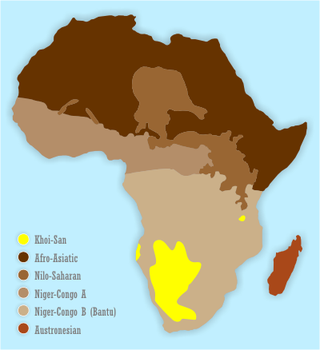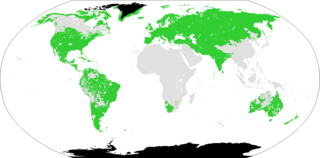Related Research Articles

The Altaic languages consist of the Turkic, Mongolic and Tungusic language families, with some linguists including the Koreanic and Japonic families. These languages share agglutinative morphology, head-final word order and some vocabulary. The once-popular theory attributing these similarities to a common ancestry has long been rejected by most comparative linguists in favor of language contact, although it continues to be supported by a small but stable scholarly minority. Like the Uralic language family, which is named after the Ural Mountains, the group is named after the Altai mountain range in the center of Asia. The core grouping of Turkic, Mongolic and Tungusic is sometimes called "Micro-Altaic", with the expanded group including Koreanic and Japonic labelled as "Macro-Altaic" or "Transeurasian".

The Khoisan languages are a number of African languages once classified together, originally by Joseph Greenberg. Khoisan is defined as those languages that have click consonants and do not belong to other African language families. For much of the 20th century, they were thought to be genealogically related to each other, but this is no longer accepted. They are now held to comprise three distinct language families and two language isolates.

Nostratic is a hypothetical language macrofamily including many of the language families of northern Eurasia first proposed in 1903. Though a historically important proposal, it is now generally considered a fringe theory. Its exact composition varies based on proponent; it typically includes the Kartvelian, Indo-European and Uralic languages; some languages from the similarly controversial Altaic family; the Afroasiatic languages; as well as the Dravidian languages.
The Proto-Human language, also known as Proto-Sapiens or Proto-World, is the hypothetical direct genetic predecessor of all human languages.
Glottochronology is the part of lexicostatistics which involves comparative linguistics and deals with the chronological relationship between languages.
Lexicostatistics is a method of comparative linguistics that involves comparing the percentage of lexical cognates between languages to determine their relationship. Lexicostatistics is related to the comparative method but does not reconstruct a proto-language. It is to be distinguished from glottochronology, which attempts to use lexicostatistical methods to estimate the length of time since two or more languages diverged from a common earlier proto-language. This is merely one application of lexicostatistics, however; other applications of it may not share the assumption of a constant rate of change for basic lexical items.
Allan R. Bomhard is an American independent scholar publishing in the field of comparative linguistics. He is part of a small group of proponents of the Nostratic hypothesis, according to which the Indo-European languages, Uralic languages, Altaic languages, and Afroasiatic languages would all belong to a larger macrofamily. The theory is widely rejected by mainstream linguists as a fringe theory. Among Nostratists, he has been described as "a maximalist who casts his nets as widely as possible" among far-flung languages not generally believed to be related.
A Swadesh list is a compilation of tentatively universal concepts for the purposes of lexicostatistics. That is, a Swadesh list is a list of forms and concepts which all languages, without exception, have terms for, such as star, hand, water, kill, sleep, and so forth. The number of such terms is small – a few hundred at most, or possibly less than a hundred; the inclusion or exclusion of many terms is subject to debate among linguists, thus there are several different lists, and some authors may refer to "Swadesh lists". The Swadesh list is named after linguist Morris Swadesh.

Merritt Ruhlen was an American linguist who worked on the classification of languages and what this reveals about the origin and evolution of modern humans. Amongst other linguists, Ruhlen's work was recognized as standing outside the mainstream of comparative-historical linguistics. He was the principal advocate and defender of Joseph Greenberg's approach to language classification.

Dené–Caucasian is a discredited language family proposal that includes widely-separated language groups spoken in the Northern Hemisphere: Sino-Tibetan languages, Yeniseian languages and Burushaski in Asia; Na-Dené languages in North America; as well as Vasconic languages and North Caucasian languages from Europe.

Sergei Anatolyevich Starostin was a Russian historical linguist and philologist, perhaps best known for his reconstructions of hypothetical proto-languages, including his work on the controversial Altaic theory, the formulation of the Dené–Caucasian hypothesis, and the proposal of a Borean language of still earlier date. None of his proposed macrofamilies have seen wide-scale acceptance in the linguistic community, though his proposals remain influential outside of academia. He was also the author of a widely respected reconstruction of Old Chinese.

Eurasiatic is a hypothetical and controversial language macrofamily proposal that would include many language families historically spoken in northern, western, and southern Eurasia.
John D. Bengtson (1948-2024) was an American historical and anthropological linguist. He had been president and vice-president of the Association for the Study of Language in Prehistory, and had served as editor of the journal Mother Tongue. Since 2001 he had been a member/researcher of Evolution of Human Languages, an international project on the linguistic prehistory of humanity coordinated by the Santa Fe Institute. His areas of specialization included Scandinavian languages and linguistics, Indo-European linguistics, Dené–Caucasian (Sino-Caucasian) languages, and paleolinguistics.

Borean is a hypothetical linguistic macrofamily that encompasses almost all language families worldwide except those native to the Americas, Africa, Oceania, and the Andaman Islands. Its supporters propose that the various languages spoken in Eurasia and adjacent regions have a genealogical relationship, and ultimately descend from languages spoken during the Upper Paleolithic in the millennia following the Last Glacial Maximum. The name Borean is based on the Greek βορέας, and means "northern". This reflects the fact that the group is held to include most language families that are native to the northern hemisphere. Two distinct models of Borean exist: that of Harold C. Fleming and that of Sergei Starostin.
Paleolinguistics is a term used by some linguists for the study of the distant human past by linguistic means. For most historical linguists there is no separate field of paleolinguistics. Those who use the term are generally advocates of hypotheses not generally accepted by mainstream historical linguists, a group colloquially referred to as "long-rangers".

Georgiy Sergeevich "George" Starostin is a Russian linguist. He is the son of the late historical linguist Sergei Starostin (1953–2005), and his work largely continues his father's. He is also known as a self-published music reviewer, author of the Only Solitaire Blog.
The Leipzig–Jakarta list of 100 words is used by linguists to test the degree of chronological separation of languages by comparing words that are resistant to borrowing. The Leipzig–Jakarta list became available in 2009. The word list is named after the cities of Leipzig, Germany, and Jakarta, Indonesia, the places where the list was conceived and created.
Sergei Lvovich Nikolaev is a Russian linguist, specialist in comparative historical linguistics, Slavic accentology and dialectology. He is the author of a number of books and articles on Indo-European studies, accentology, and Slavic dialectology. Nikolaev is a Doctor of Sciences in Philological Sciences.

Ilia Peiros is a Russian linguist who specializes in the historical linguistics of East Asia. Peiros is a well-known scholar in the Moscow School of Comparative Linguistics, known for its work on long-range comparative linguistics. Peiros is affiliated with the Santa Fe Institute in New Mexico, United States and was also a former faculty member at the University of Melbourne.
The Moscow School of Comparative Linguistics is a school of linguistics based in Moscow, Russia that is known for its work in long-range comparative linguistics. Formerly based at Moscow State University, it is currently centered at the RSUH Institute of Linguistics, and also the Institute of Linguistics of the Russian Academy of Sciences in Moscow, Russia.
References
- ↑ "Evolution of Human Languages: An international project on the linguistic prehistory of humanity". ehl.santafe.edu. Santa Fe Institute. Retrieved December 31, 2012.
- ↑ Velasquez-Manoff, Moises (July 20, 2007). "Linguists seek a time when we spoke as one". USA Today. Retrieved December 31, 2012.
- ↑ Mark Pagel, Quentin D. Atkinson, Andreea S. Calude, Andrew Meade. Ultraconserved words point to deep language ancestry across Eurasia. Proceedings of the National Academy of Sciences May 2013, 110 (21) 8471-8476; doi : 10.1073/pnas.1218726110
- ↑ "Evolution of Human Languages": current state of affairs (March 2014).
- ↑ Woodward, Richard B. "The Man Who Loved Languages: A Scholar with the Ability and Audacity to Rebuild the Tower of Babel Died a Year Ago, but His Controversial Project Lives on." The American Scholar 75, no. 4 (2006): 44-57. Accessed December 27, 2020.
- ↑ Evolution of Human Languages - The Participants.
- ↑ "Evolution of Human Languages - An Introduction" at Santafe.edu, retrieved 25 October 2007. New link, see here. Accessed Oct 27, 2009.
- ↑ The Tower of Babel project. at Starling.rinet.ru, retrieved 25 October 2007.
- ↑ Unified Transcription System (UTS) for the Global Lexicostatical Database.
- ↑ Starostin, George (ed.) 2011-2019. The Global Lexicostatistical Database . Moscow: Higher School of Economics, & Santa Fe: Santa Fe Institute. Accessed on 2020-12-26.
- ↑ Kassian, Alexei, George Starostin, Anna Dybo, Vasiliy Chernov. 2010. The Swadesh wordlist. An attempt at semantic specification. Journal of Language Relationship 4: 46–89. (PDF)
- ↑ Starostin, George. Preliminary lexicostatistics as a basis for language classification: A new approach. Journal of Language Relationship , No. 3 (2010). P. 79–116.